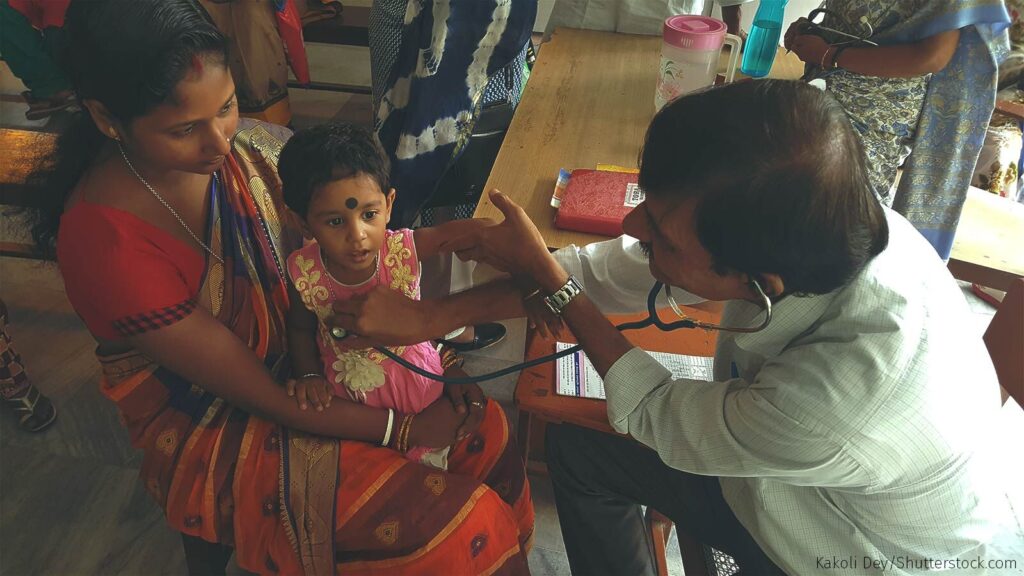West Bengal Outperformed States That Implemented PM’s Health Insurance Scheme, On Key Indicators

The PMJAY scheme aims to provide Rs 5 lakh health insurance coverage per year to nearly 110 million economically vulnerable families, or 500 million people. PMJAY is jointly implemented by the central and state governments in 32 states and UTs. West Bengal, Telangana, Odisha and Delhi have not implemented PMJAY. The Telangana government has announced in December 2020 that it intends to participate in PMJAY.
As PMJAY implementation began in 2018, data from the fourth (2015-16) and fifth (2019-20) rounds of the National Family Health Survey (NFHS), India’s largest official household health survey used for framing health policy, would adequately capture pre- and post-implementation health outcomes, the Economic Survey said. This would enable an assessment of the impact of PMJAY.
The Economic Survey concluded that of 22 states and UTs covered in Phase 1 of NFHS-5 (2019-20), PMJAY states were showing greater improvements than non-PMJAY states on several indicators. West Bengal had been outperformed by PMJAY-implementing neighbours on many of these indicators, the Centre’s survey said.
“Most of the indicators used in the report have nothing to do with PMJAY. For example, PMJAY does not offer vaccination or ante-natal care visits. PMJAY is restricted to hospitalisations. So the Economic Survey’s assessment of PMJAY improving various such health parameters is flawed to begin with,” Sulakshana Nandi, Chhattisgarh convenor of the Public Health Resource Network, and a researcher on state-funded insurance schemes, told IndiaSpend.
The Survey, all the same, has made a larger conclusion–that multiple health indicators have improved in states which have implemented the scheme. IndiaSpend analysed the same data used in the Economic Survey to verify the claims, and found that the picture is more complex. We also analysed other indicators to see if the premise of the Economic Survey stands, and found that West Bengal was often performing higher than the states it has been compared with.
While the claims in the Economic Survey are technically correct, West Bengal’s health data have been compared to the average of its three neighbours’ after adding their health data together. It is unclear why data of one state should be compared to average aggregated data of three other states.
Being West Bengal’s neighbours, Bihar, Assam and Sikkim are therefore “similar on socio-economic dimensions,” the Economic Survey has claimed. None of these states, however, share a border with each other, and their socio-economic dissimilarities are underscored by the same NFHS data the Economic Survey has used.
Further, should health data of Bihar, India’s poorest and third-most populous state, situated in the Gangetic plain, be grouped with that of India’s second-wealthiest and least populous state Sikkim, a former Himalayan kingdom, to make a comparison with a third state? That would be akin to comparing upper middle-income country Mexico’s gross domestic product (GDP) to the combined GDP of its northern and southern neighbours, high income United States and upper-middle income Guatemala, respectively. Mexico’s GDP would inevitably be lesser.
In fact, West Bengal outperformed its neighbours and other large states that implemented PMJAY, on several health indicators mentioned by the Economic Survey, including infant and child mortality, child vaccinations and use of family planning methods, per the same NFHS data disaggregated by individual state, our analysis shows. Bihar’s performance was poor on several indicators, but this was not evident from the aggregated outcomes. Many states have shown worsening infant and child mortality, despite implementing PMJAY.
Further, the Survey used “difference-in-difference” calculations–that is, relative difference in improvement between states. In such analyses, states that have more ground to cover to begin with would seem to be performing better than those that were better off in the first place–a fact that the Survey alludes to when it mentions a “higher base” or a “lower base”.
Moreover, health insurance coverage is only one way to assess access to health; affordability is another, health researchers tell us. For instance, increased coverage under PMJAY should reflect both higher institutional newborn deliveries and a decrease in out-of-pocket expenditure (OOPE) for the same, they say, but PMJAY has not had a positive bearing on either. On these indicators, West Bengal has outperformed both its neighbours and all large states that have implemented PMJAY, NFHS data show. In 12 of 20 PMJAY states, OOPE on delivery increased by between 3% and 130%.
Claim: PMJAY implementation enhanced health insurance coverage in states adjacent to West Bengal by 89%, while coverage fell 12% in the latter
PMJAY enhanced health insurance coverage by 54% in states and UTs included in Phase 1 of NFHS-5 (2019-20), in the four years since NHFS-4 (2015-16), said the Economic Survey, while falling by nearly 10% in non-PMJAY West Bengal and Telangana. In West Bengal’s neighbours Bihar, Assam and Sikkim, the proportion of households with health insurance coverage increased by 89%, while in West Bengal, the same metric declined by 12%, said the Economic Survey.
Disaggregating the four states on individual performance, health insurance coverage increased by 2.3 and 49.6 percentage points in Bihar and Assam, respectively. In Sikkim, coverage decreased by 4.6 and in West Bengal by 4.1 percentage points, our analysis shows.
This content was originally published here.




Responses